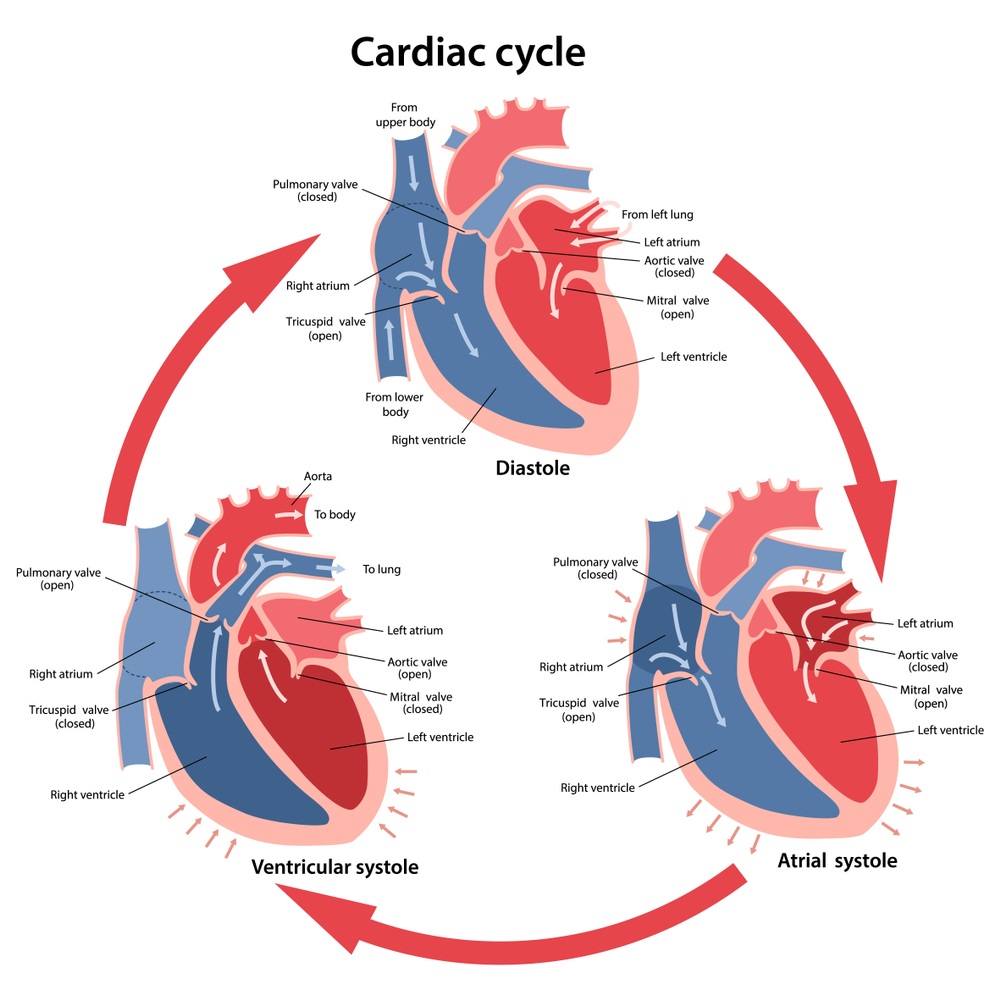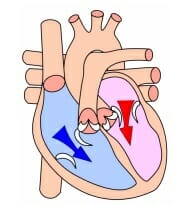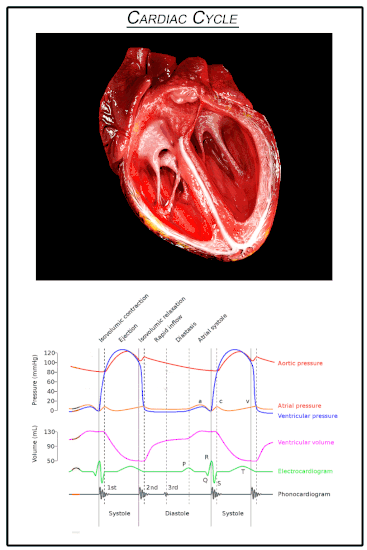Definition
The cardiac cycle is the series of contractions in the heart that pressurize different chambers, causing blood to flood in one direction. There are two stages during the cardiac cycle. During diastole, the ventricles relax and fill with blood. The muscles contract during systole, pushing blood through the arteries.
Cardiac Cycle Explained
The cardiac cycle varies in different organisms, due to changes in the structure of the heart. Fish have a two-chambered heart, with unidirectional flow. Some organisms have a three-chambered heart, which consists of the sinus venosus, atrium, and ventricle. This is seen in organisms such as reptiles and amphibians.
Mammals and birds have developed a more efficient 4-chambered heart, which can supply a greater pressure of blood to the organisms. The 4-chambered heart is actually just a modification of the 3-chambered heart. The sinus venosus is reduced to the sinoatrial node, located on the right atrium. The atrium and ventricles are divided in the four-chambered heart, allowing a separate pathway to be established to the lungs. The separate circulations pathways are known as pulmonary circulation (to the lungs) and systemic circulation (to the body).
The following cardiac cycle phases are representative of the mammalian, four-chambered heart. The cardiac cycle of animals with three-chambered hearts is similar, except the atria and ventricles are not divided completely, if at all. Hagfish, and other organisms that have a more ancestral heart, simply use the heart to move liquid through their body at a slow rate. In organisms such as this, the cardiac cycle is much less distinguished because the heart does not set up a specific rhythm.
In most animals, the heartbeat is regulated by nerves in the sinoatrial node and carried out by nerves throughout the heart. Heart muscles cells are also connected laterally, allowing them to pass the nerve impulse received to all their neighbors, creating rhythmic contractions.

Cardiac Cycle Phases
The two main phases of the cardiac cycle are systole and diastole, and they follow each other in sequence. Each stage in the cardiac cycle contains important steps which direct the flow of blood properly. These steps include contractions of heart chambers and the proper opening and closing of specific heart valves.
Diastole
The diastole phase begins with the relaxation of all the heart muscles. During diastole, blood returns to the heart and begins to fill the atria and ventricles. The lack of pressure in the ventricle allows the mitral and tricuspid valves to open, which allow blood from the atria into the left and right ventricles, respectively. This phase of the cardiac cycle can be seen in the image below.

A signal sent to the sinoatrial node induces the muscles of both atria to contract. In unison, this forces blood out of the atria and into the ventricles. Most of the blood leaves the atria at this point in the cardiac cycle. As the atria squeeze, the action potential is passed through the muscles and nerves of the heart to the ventricles.
Systole
Another wave of contraction starts as the ventricles enter ventricular systole and begin contracting themselves. The increased pressure in the ventricles closes the mitral and tricuspid valves. The pressure pushes open the aortic and pulmonary valves. This can be seen in the image below. This starts the systole part of the cycle.

The ventricles contract hard, pushing most of the blood they contain into the pulmonary and systemic circulation. The aorta is the main artery that feeds oxygenated blood to the body and is attached to the left ventricle. The pulmonary artery exits the right ventricle and carries unoxygenated blood to the lungs. This blood then returns and enters the left atrium. Here it drains into the left ventricle to be pumped out to the body.
The body uses the oxygen and returns the blood to the right atrium, and the cycle starts over. While it may take a while for one pump of blood to circle the body, the heart continues the cardiac cycle indefinitely, to ensure the movement of nutrients and oxygen in the body, as well as remove toxic metabolic wastes.
The Cardiac Cycle Video
The entire cardiac cycle can be seen in the following animation, which tracts the cardiac cycle along with the pressure and volume of different chambers.

An import tool to measure the cardiac cycle is the electrocardiogram, which can be seen as the green line on the above graph. The electrocardiogram is a signal which can be measured by sensitive medical electronics and provides a glimpse of the cardiac cycle. The “QRS” on the green line indicates significant points in the signal, and correspond to the contraction of the ventricles. The study of electrocardiograms can lead to important insights into the functioning of the heart. Not only the presence of a signal, but the strength of the signal and the spacing of the events are all significant measurements of heart function.
Quiz
